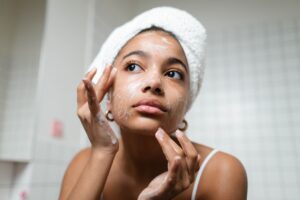How Do They Work?

Have you ever wondered how your skincare products actually work? With so many different types of products on the market, it can be overwhelming to understand the science behind them. In this blog post, we’ll break down the mechanisms behind some of the most common skincare products and ingredients.
Decoding the Ingredients in Your Skincare Products
When it comes to skincare products, the ingredients list can be a bit daunting. However, understanding what each ingredient does can help you make informed decisions about what products to use.
Hyaluronic Acid
One common ingredient you may have heard of is hyaluronic acid. This molecule is naturally found in the body and is known for its ability to hold onto water. When used in skincare products, it can help to hydrate and plump the skin.
Vitamin C
Another ingredient that has gained popularity in recent years is vitamin C. This powerful antioxidant can help to brighten the skin and reduce the appearance of fine lines and wrinkles.
Aloe Vera
If you’re looking for a natural skincare ingredient, look no further than aloe vera. This plant extract is known for its soothing and hydrating properties, making it a great addition to products designed for sensitive skin.
The Role of pH in Skincare
Did you know that the pH of your skincare products can have a big impact on their effectiveness? The pH scale ranges from 0 to 14, with 7 being neutral. The skin’s natural pH is around 5.5, which is slightly acidic.
Using products that are too alkaline can disrupt the skin’s natural barrier function, leading to dryness and irritation. On the other hand, using products that are too acidic can also be problematic, causing inflammation and redness.
When selecting skincare products, look for ones that are pH balanced to ensure that they are gentle and effective. Some examples of pH balanced products include CeraVe Hydrating Cleanser and La Roche-Posay Toleriane Double Repair Face Moisturizer.

Understanding the Mechanisms of Skincare Products
Now that we’ve covered some common skincare ingredients and the importance of pH, let’s dive into the mechanisms behind how some of these products work.
Moisturizers
Moisturizers are a staple in any skincare routine, but how do they actually work? Simply put, moisturizers work by trapping water in the skin. This can be achieved through the use of occlusive ingredients, which create a barrier on the skin’s surface to prevent water loss, or humectant ingredients, which attract water to the skin.
Retinoids
Another popular skincare product is retinoids. These vitamin A derivatives are known for their ability to reduce the appearance of fine lines and wrinkles, as well as improve skin texture and tone. Retinoids work by increasing cell turnover and stimulating collagen production, resulting in smoother, more youthful-looking skin.
Coconut Oil
If you’re looking for a natural skincare product, consider incorporating coconut oil into your routine. This oil is rich in fatty acids and can help to hydrate and soften the skin, as well as promote hair health.
In conclusion, understanding the science behind skincare products can help you make informed decisions about what products to use in your routine. Look for ingredients that are proven to be effective and consider the pH of your products to ensure that they are gentle and non-irritating. And don’t forget, natural hair care ingredients like aloe vera and coconut oil can also be great additions to your skincare routine!




